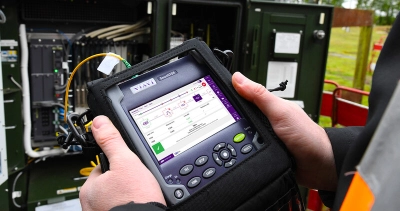Engineers utilize the optical fibre diameter analyser to ensure fibre uniformity.
Engineers utilize the optical fibre diameter analyser to ensure fibre uniformity.
Blog Article
Exploring the Conveniences of Optical Fiber Evaluating for Boosted Interaction Equipments
The value of optical fiber testing in contemporary interaction systems can not be overemphasized, as it offers as a foundation for guaranteeing network dependability and efficiency. This proactive testing method has profound effects for signal top quality and functional performance, raising the inquiry of exactly how these practices add to lasting sustainability in an ever-evolving technological landscape.
Importance of Optical Fiber Screening
The relevance of optical fiber testing can not be overstated in today's data-driven setting. As companies significantly depend on high-speed information transmission for daily procedures, the integrity and efficiency of optical fibre networks are critical. Checking makes sure that these networks can support the substantial amounts of data created and transferred seamlessly, fostering efficient communication and connectivity.
Optical fiber testing serves numerous critical features, consisting of confirming installation quality, determining possible faults, and establishing overall system efficiency. Regular testing can protect against expensive downtimes and service disruptions, enabling organizations to preserve operational connection. It helps in conformity with market standards and guidelines, ensuring that fiber optic installments fulfill called for requirements for safety and reliability.
In addition, testing can boost the durability of fibre optic systems. By proactively identifying issues such as signal loss, depletion, or port failures, companies can resolve troubles prior to they intensify, thus expanding the life of their facilities. In recap, optical fiber screening is not just a technological requirement however a strategic investment that boosts network dependability, maximizes performance, and inevitably sustains the growth and performance of modern-day communication systems.
Trick Evaluating Approaches

OTDR is an important method utilized to recognize mistakes, action splice losses, and assess the general stability of a fibre optic link. By sending out a pulse of light down the fibre and evaluating the mirrored light, specialists can pinpoint places of mistakes and examine the network's performance over fars away.
Insertion loss screening measures the amount of signal loss that happens when light passes through a connection or splice. This technique is important for verifying that links fulfill given loss thresholds, which is crucial for keeping ideal efficiency in communication systems.
Optical return loss screening evaluates the amount of light showed back in the direction of the resource because of imperfections in the fiber or connections. High return loss values suggest far better performance and minimized signal degradation.
Together, these testing methods provide a thorough evaluation of fiber optic networks, guaranteeing their reliability and functionality in diverse interaction applications.
Effect On System Efficiency
Effective optical fiber screening directly influences the overall performance of communication systems. By guaranteeing the integrity of fiber optic wires, screening recognizes potential mistakes such as attenuation, splice loss, and connector misalignment. These problems can considerably deteriorate signal top quality, resulting in disturbances and lowered information transmission rates.
Additionally, normal optical fiber testing adds to long-term system sustainability. It allows early detection of damage, permitting prompt maintenance and upgrades prior to significant failures happen. This not only lengthens the life expectancy of the framework however additionally guarantees that interaction systems remain competitive in regards to efficiency.
Cost-Effectiveness and Effectiveness
Cost-effectiveness is a crucial factor to consider in the implementation and maintenance of optical fiber networks. Carrying out robust optical fiber testing treatments can substantially decrease functional expenses by determining concerns prior to they intensify right into major issues. optical fibre testing equipment. By spotting mistakes, attenuation, and other efficiency obstacles early, organizations can avoid costly repairs and downtime, which can interfere with services and result in profits loss
In addition, effective screening methodologies simplify the installment process, permitting technicians to work better. This translates to reduce work prices and faster task completion times. Advanced screening devices, such as Optical Time Domain Name Reflectometers (OTDRs), allows a specific assessment of fibre high quality, making sure that only optimal materials are utilized, thus lessening waste.
Normal screening additionally adds to far better resource appropriation. By recognizing the network's performance, companies can make educated decisions concerning upgrades and developments, making sure that investments are made where they are read here most needed. In recap, optical fibre screening boosts cost-effectiveness and effectiveness, supporting the lasting sustainability and competitiveness of interaction systems in a significantly demanding market.
Making Certain Long-Term Integrity
Carrying out rigorous optical fiber screening not just improves price financial savings and operational performance but also plays a pivotal function in making sure the long-lasting reliability of interaction networks. Regular screening practices, including attenuation and transmission capacity analyses, assistance identify prospective deterioration in fibre efficiency prior their explanation to it causes service disruptions.
By employing innovative screening approaches, network operators can pinpoint faults or weak points in the fibre facilities, enabling for timely remediation. This aggressive method lessens downtime, making sure that communication systems stay functional and reliable. Regular screening contributes to the development of a more click here for info resistant network, as drivers can adapt and optimize their framework based on real-time information insights.
Additionally, making certain compliance with sector requirements via optical fibre testing strengthens the quality and stability of the entire interaction system. This adherence not only strengthens self-confidence among stakeholders but additionally aligns with governing requirements, which are increasingly strict.
Final Thought
Finally, optical fibre testing functions as an essential element in enhancing communication systems. By utilizing numerous screening approaches, such as OTDR and insertion loss analyses, networks can achieve optimum efficiency and integrity. The proactive recognition of mistakes not just boosts signal top quality but also decreases downtime, eventually contributing to cost-effectiveness and operational performance. Adherence to market requirements fosters stakeholder self-confidence, ensuring the long-lasting sustainability of communication infrastructures in an increasingly data-driven landscape.
Report this page